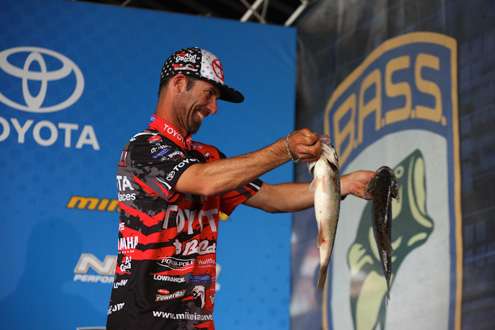
MONTGOMERY, ALABAMA – Elite Series Pro Cliff Pace wrote a guest column for Bassmaster.com last week that, though only a few paragraphs long, spoke volumes about how technology has changed the game of fishing.
There is the obvious – from high tech boats to depth finders to whisper-quiet trolling motors. And then there is the not so obvious, things like Google Earth and similar websites that provide up to the minute satellite images, water reports, depth charts and much, much more.
These are the tools of the modern-day Bassmaster Elite Series angler and the overwhelming majority of these guys are armed to the gills with as much information as they can handle.
They were expected to need all of it and more during the Bassmaster Elite Series Alabama River Charge presented by Star brite. And for sure, the technology has helped numerous anglers immensely this week. But when the river goes 10 feet above its usual levels and the current runs at 10 miles per hour or more in some places, that’s when the anglers have to go back to their gut instincts.
They have to think like an angler would before technology provided overhead images of a backwater or slough located in the most remote corner of a riverine system. They have to listen to the voices that gave them the ability to earn a spot on the most challenging bass fishing tour in the world.
But admittedly, they still go to their technology, just as well.
Take Michael Iaconelli, for instance. He’s firmly straddled between seasoned pro and being a “new school” angler, if you will. He’s been around the tour long enough to know that he needs a healthy dose of his “old school” instincts and his “new school” smarts.
Not surprisingly, he’s a big fan of technology and how it helps him prepare for a tournament.
“It has a huge impact on what I do,” Iaconelli said. “Whether you talk about Google Earth, or site imaging or satellite imaging, it’s changed everything for us. I use a site called Fishidy.com. What they do is take traditional satellite imaging like Google or Bing and they lay overlay counters on top of it. It’s a really cool feature. I use it every tournament; whether it’s a river system like this, a reservoir, or a man-made lake, natural lake, whatever.
“I have an ipad in my boat now with my Lowrance units. So from a navigational standpoint, it’s a big help learning the backwaters. And from a scouting standpoint, it shows water quality, historic images. It’s pretty amazing.”
But what effect did it have on Ike’s catch this week? Well, on Day 1, he sacked 17 pounds, 5 ounces and was in ninth place. Though he slipped a bit on Friday, he said the technology helps, regardless.
“It makes it easier and it saves time,” he said. “Fifteen years ago, it took a lot of time to get into those backwaters and see if it was something you wanted to fish. Now, you know that beforehand. I’d say 70 percent of the Elite guys (are using some sort of technology on their boats and in their planning.)
Ott DeFoe is a big fan of technology, in both the planning and fishing stages of the game. And on a fishery like this, it can make an even bigger difference, he said.
“You have the Alabama, the Coosa, the Tallapoosa – all these different rivers that you don’t even know they’re all connected or what’s going on,” DeFoe said.
DeFoe favors the U.S. Geological Survery website, as well as Google Earth, when planning for a tournament. It’s worked for him here before, as he won the Elite Series All Star Championship on the Alabama River in 2011.
“You see things at different stages, different levels,” he said. “You can find places where you can get in and places where you can’t get in. It’s a view from the air and it helps. I don’t know if it’s possible to hinder you, but sometimes you can make an overeducated decision. You can outsmart yourself. I looked at the water temperature on the Tallapoosa Rive (and his techno research) had it at 59 degrees and it was 65. So, I kind of wrote it off and a lot of guys caught fish out of there. Sometimes it’s good to have all that information, and sometimes it’s not.”
Cliff Pace knows that well, though it must be said this tournament is fishing differently than anyone expected, with its flooding and fast current that had the upriver stretches of the system being extremely productive for most anglers. Pace studied his technology hard before and during the tournament, but only caught a two-day total of 15 pounds, 4 ounces, which didn’t make the cut.
He said that’s because he went downriver.
“I felt like fishing the lower part of the river would be best because historically that’s been the case,” Pace said. “It just looks like it has better habitat. But it really bit me. I’m probably going to finish dead last and (the guys upriver) crushed them.”
These technological advances also have been said to cut into a “hometown advantage,” if you will – the kind of know-how that Russ Lane gets from living in Prattville, which is 15 minutes from downtown Montgomery. Lane finished with a 25-7 total over two days.
“There’s no such thing as home-field advantage with these guys,” Lane said of having to compete with his fellow Elite Series pros.
But, as Iaconelli pointed out, there is always something every angler has over any machine – and it doesn’t matter how intensely you study the technology that’s out there.
“At its core, you still have to have the instinctual ability to fish,” Iaconelli said. “Sometimes, the guys that grow up without that ‘advantage’ are better, because they have that natural instinct. And really, even will all the toys available, that’s what it’s all about.”

